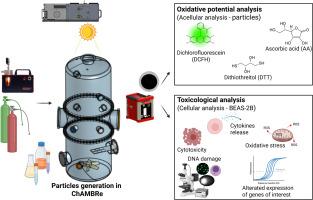碳质气溶胶在大气模拟室内老化的氧化电位和细胞毒性。
IF 3.4
3区 医学
Q2 PHARMACOLOGY & PHARMACY
引用次数: 0
摘要
本研究利用大气模拟室(ASC)研究了化学成分、大气老化和环境条件对烟灰颗粒氧化电位(OP)和细胞毒性的影响。在ASC室中模拟了真实世界的夏季和冬季情景,将纯烟尘颗粒(由微型倒立烟尘发生器产生)和各种二次气溶胶前体(即甲苯、2,5-二甲基呋喃和α-蒎烯)交替暴露于光照或黑暗条件和不同的氧化剂中。使用多种检测方法(即2′,7′-二氯荧光素- DCFH、二硫索糖醇- DTT和抗坏血酸- AA)评估OP,发现暴露在光线下的煤烟颗粒,特别是在甲苯存在的情况下,表现出更高的OP。甲苯的存在还增加了细胞活性氧(ROS)的产生,导致BEAS-2B细胞毒性升高、DNA损伤和促炎细胞因子白细胞介素-8 (IL-8)的释放。硫酸铵的加入降低了OP,但没有增强毒理学反应,表明老化颗粒物(PM)中的无毒成分可能减轻一些有害影响。毒理学评估显示,与低辐照度的冬季相比,夏季和交通环境中高辐照条件下产生的烟尘的细胞毒性、遗传毒性、氧化应激和炎症反应增加。OP与毒理学终点(如ROS形成、LDH释放、微核形成和IL-8分泌)之间存在很强的相关性,这强调了化学成分和环境老化在决定PM毒性中的作用。该研究强调了OP分析作为预测pm诱导的氧化应激和潜在健康影响的可靠工具,强调了在城市空气污染评估中考虑烟尘化学成分和老化过程的重要性。本文章由计算机程序翻译,如有差异,请以英文原文为准。

Oxidative potential and cellular toxicity of carbonaceous aerosols undergoing aging in an atmospheric simulation chamber
This study investigates how chemical composition, atmospheric aging, and environmental conditions affect the oxidative potential (OP) and cellular toxicity of soot particles using an atmospheric simulation chamber (ASC). In the ASC ChAMBRe were simulated real-world summer and winter scenarios, exposing pure soot particles (generated by using the mini-inverted soot generator) and various secondary aerosol precursors (i.e., toluene, 2,5-dimethylfuran and α-pinene) alternatively to light or dark conditions and different oxidants. OP was assessed using multiple assays (namely, 2′,7′-dichlorofluorescein – DCFH, Dithiothreitol - DTT and Ascorbic Acid – AA), revealing that soot particles exposed to light, especially in presence of toluene, exhibited higher OP. The presence of toluene also increased cellular reactive oxygen species (ROS) production, leading to elevated cytotoxicity, DNA damage, and release of the proinflammatory cytokine interleukin-8 (IL-8) in BEAS-2B cells. Ammonium sulfate addition reduced OP and do not enhance toxicological responses, suggesting that non-toxic components in aged particulate matter (PM) may mitigate some harmful effects. Toxicological assessment showed increased cytotoxicity, genotoxicity, oxidative stress, and inflammatory responses in soot generated under high irradiance conditions typical of summer and traffic environments, compared to low irradiance winter scenarios. Strong correlations were observed between OP and toxicological endpoints, such as ROS formation, LDH release, micronuclei formation, and IL-8 secretion underscoring the role of chemical composition and environmental aging in determining PM toxicity. The study highlights OP assays as a reliable tool for predicting PM-induced oxidative stress and potential health effects, emphasizing the importance of considering soot chemical composition and aging processes in urban air pollution assessments.
求助全文
通过发布文献求助,成功后即可免费获取论文全文。
去求助
来源期刊
CiteScore
6.80
自引率
2.60%
发文量
309
审稿时长
32 days
期刊介绍:
Toxicology and Applied Pharmacology publishes original scientific research of relevance to animals or humans pertaining to the action of chemicals, drugs, or chemically-defined natural products.
Regular articles address mechanistic approaches to physiological, pharmacologic, biochemical, cellular, or molecular understanding of toxicologic/pathologic lesions and to methods used to describe these responses. Safety Science articles address outstanding state-of-the-art preclinical and human translational characterization of drug and chemical safety employing cutting-edge science. Highly significant Regulatory Safety Science articles will also be considered in this category. Papers concerned with alternatives to the use of experimental animals are encouraged.
Short articles report on high impact studies of broad interest to readers of TAAP that would benefit from rapid publication. These articles should contain no more than a combined total of four figures and tables. Authors should include in their cover letter the justification for consideration of their manuscript as a short article.

 求助内容:
求助内容: 应助结果提醒方式:
应助结果提醒方式:


